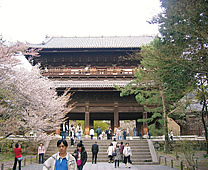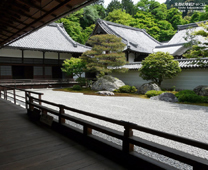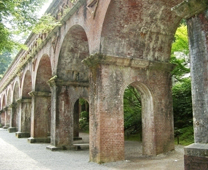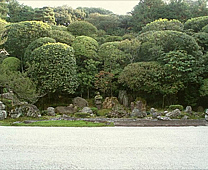
Travel Guide
Introduction
Nanzenji Temple, or Zuiryusan Nanzenji Temple, formerly Zenrinji Temple, is considered as the most important Zen Buddhist temple in Kyoto. It is listed over the Kyoto Gozan, which has the highest rank among the Kyoto zen temples.
Emperor Kameyama established it in 1291 on the site of his previous detached palace. It is also the headquarters of the Nanzenji Temple branch of Rinzai Zen. Zenkei Shibayama, who provided a popular commentary on the Mumonkan, was an abbot of the monastery. The precincts of Nanzenji Temple are a nationally designated Historic Site and the Hojo gardens a Place of Scenic Beauty.
History
The history of Nanzenji Temple dates back to the mid 13th century, when the Emperor Kameyama built his retirement villa at the temple's present location and later converted it into a Zen temple. Main buildings were lost by fire and rebuilt in 1393 and 1447. In the year 1467, all of the buildings were reduced to ashes by fires of civil war of the late Muromachi Period (1333-1573) and they had to wait until 1605, when Ishin Suden became the chief priest of the temple, to be able to rebuild the buildings. The oldest of the current buildings were built after that period.
 |
Sanmon Visitors will first come across Nanzenji's massive Sanmon entrance gate, which extends over the treetops. The gate was constructed in 1628 by the ruling Tokugawa clan for soldiers who died in the siege of Osaka Castle in 1615. It is possible to climb up to the gate's balcony, from where the view extends across the city. Behind the gate is the Hatto (Dharma Hall), a large lecture hall which cannot be entered by the public. Don't miss the statue of Goemon Ishikawa, a Robin Hood-style outlaw of Japan who hid in this gate until his capture. From the top floor of the gate you can view Kyoto spread out below. The upper floor also contains Buddha statues and paintings. |
 |
Hojo (Abbot's Quarters) Dai Hojo was brought from Kyoto's Imperial Palace (Gojo) in 1611. Dai Hojo is the former head priest's residence and Nanzenji's main hall, a National Treasure. Dai Hojo is most famous for its rock garden whose rocks are said to resemble tigers and cubs crossing through water. Sho Hojo (National Traeasure) is known for its dry stone garden and painted fusuma. Highly regarded are the paintings on fusuma (sliding doors) in Sho Hojo, which include a more realistic depiction of tigers on gold leaf. The rooms of the Sho Hojo have paintings by artists of the Kano School including a series of tigers in a bamboo grove by Kano Eitoku (1543-1590) and the beams are carved by the wood master Hidari Jingoro (1594-1634). Visitors enter the Dai Hojo building complex through the former temple kitchen (kuri), where they can also find a small tea room to their right with a view of a miniture waterfall. |
 |
Aqueduct Built during the Meiji Period (1868-1912), the red brick aqueduct is part of a canal system that was constructed to carry water and goods between Kyoto and Lake Biwa in neighbouring Shiga Prefecture. Paths run alongside the canal that lead into the surrounding forest. |
 |
Subtemples Nanzenji has 12 sub-temples but not all of them are open to the public on a regular basis. However Nanzen-in, Tenju-an, Konchi-in and Choso-in can be visited. The subtemple said to be the heart of Nanzenji is Nanzen-in. Nanzen-in is a 1703 reconstruction of the original retirement villa of Emperor Kameyama, which was the first building at the Nanzenji complex. The temple contains a garden with a heart-shaped pond. Tenju-an Open only in the spring and fall, Tenju-an was founded in the 14th century in honor of the priest Fumon but the present buildings date from two centuries later. There are painted fusuma by Hasegawa Tohoku and some beautiful gardens. The cemetery has the grave of Hosokawa Yusai aka Hosokawa Fujitaka (1534-1610), the poet daimyo who became a priest in later life and was responsible for rebuilding the temple. Konchi-in's Abbot's Quarters were transported from Hideyoshi's Fushimi Castle. Konchi-in is most noted for a dry garden by Kobori Enshu and a memorial to Ieyasu Tokugawa built in a mix of Buddhist and Shinto styles. Choso-in has a garden noted for its azaleas and a statue of Marishi-ten (The Queen of Heaven) brought from China by the monk Seisetsu. The Okutan restaurant serves vegetarian tofu lunches either inside or on decks overlooking the garden and pond. |
Travel Advice
Sightseeing
- Kyoto Gozan includes Tenryuji Temple, Shokokuji Temple, Kenninji Temple, Tofukuji Temple and Manjuji Temple. The head temple presiding over the Gozan in Kyoto is Nanzenji Temple.
Yu-Tofu (hot- bean curd)
There are some fine bean curd restaurants to be found around Nanzenji Temple. During the Edo-period (1603-1867) there was a good high quality water supply here, so making tofu was very profitable at that time, and some restaurants on the approach road to the temple served visitors their unique and delicious yu-dofu. Since then it has become one of the most popular of Nanzenji Temple’s characteristics. One of the shops has even been in existence for 360 years.
Five Mountain System
The Five Mountain System was a network of state-sponsored Zen Buddhist temples created in China during the Southern Song Dynasty (1127–1279). The term "mountain" in this context means "temple" or "monastery", and was adopted because many monasteries were built on isolated mountains. The system originated in India and was later adopted also in Japan during the late Kamakura period (1185–1333).
In the end of Kamakura period, Hojo Family broght the system to Japan, picked up five zen temples as Gozan (Five Mountain) from the temples in Kamakura. Emperor Godaigo listed Nanzenji Temple as the first rank, or the highest rank, in 1334, but in 1386, after the 3rd shogun Yoshimitsu Ashikaga founded Shokokuji Temple, Five Mountain System was reformed, Gozan was split into Kyoto Gozan and Kamakura Gozan, Nanzenji Temple was listed over the Kyoto Gozan, this makes Nanzenji Temple also called "over the Gozan".
Kyoto Gozan includes Tenryuji Temple, Shokokuji Temple, Kenninji Temple, Tofukuji Temple and Manjuji Temple. The head temple presiding over the Gozan in Kyoto is Nanzenji Temple.
Japanese Zen Culture
In the year 1410 a Zen Buddhist monk from Nanzenji Temple wrote out a landscape poem and had a painting done of the scene described by the poem. Then, following the prevailing custom of his day, he gathered responses to the images by asking prominent fellow monks and government officials to inscribe it, thereby creating a shigajiku poem and painting scroll. Such scrolls emerged as a preeminent form of elite Japanese culture in the last two decades of the fourteenth century, a golden age in the phenomenon now known as Japanese Zen culture.
Autumn Leaves
Nanzenji Temple is a spot to see autumn leaves. Please see Autum Leaves in Nanzenji Temple.
Visit
| Address | Fukuchi-cho, Nanzenji, Sakyo-ku, Kyoto-shi, Kyoto | |
| Phone | 075-771-0365 | |
| Admission | Nanzen-in Adult: 300 yen Student: 250 yen Child: 150 yen Hojo Garden and Sanmon Adult: 500 yen Student: 400 yen Child: 300 yen |
Adult: over 18 Student: 15 to 17 Child: 6 to 14 Group tickets are available |
| Hours | 08:40 to 16:30 Feb 1 to the last date of Fed 08:40 to 17:00 Mar 1 to Nov 30 |
Entry until 20 minutes before closing |
| Closed | December 28 to 31 is not open to public | |
| Duration | 30 minutes | |
| Getting There | By Train 10 minute walk from Keage Station on subway Tozai Line. Take City Bus to Higashitennocho or Nanzenji Temple and Eikando-michi bus stop, then walk approximately 1 minute. By Car Take Meishin Expressway to the Kyoto-higashi exit. It is approximately 5 kilometers 20 minutes from exit. |
|
| Parking | Paid parking available | |

